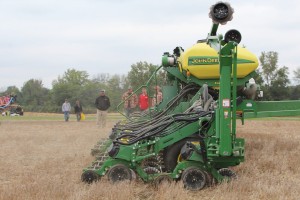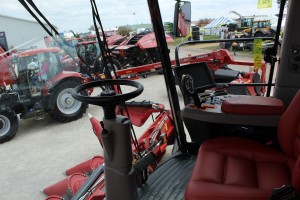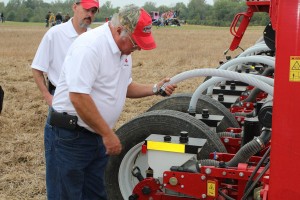SALEM, Ohio — Technology is changing the way the world operates and farming is not immune.
John Deere, Case, Agco and New Holland were at the Farm Science Review to show off what they say farmers need in order to stay profitable and up to date. The three-day event drew more than 131,000 people.
New software
The John Deere Co. has announced new software updates to their website and other technology to help farm operators manage their fleet, fields and machines.
Kathy Sponheim, John Deere senior product manager, said farmers need to develop an understanding of myjohndeere.com. It’s an operator center and has a lot of functionality that provides analytical tools that allow farmers to collect data about their tractors, equipment operators and agronomy data from the fields.
Another update is wireless data transfer. The newest equipment features JDLink, which provides cell service for the machine no matter where it’s working.
The service also allows the data to be uploaded, and agronomic data can be shared with the farmer’s agronomist.
The farmer can tell exactly where drainage tile may need installed or repaired. It can also tell the farmer where more nitrogen is needed or a farmer can establish whether or not pests are a problem.
The way MyJohnDeere.com works is that users need a password and user name, and it uses bank trusted security to prevent hacking. Then, once your account is established you can share your information with advisors through the system. But, farmers have to be part of myjohndeere.com and partnerships have to be established.
Security alerts
Another new John Deere tech. trait is security. By having the GPS system and by using myjohndeere.com, the technology can provide peace of mind.
Sponheim said the technology can send out alerts about the equipment’s oil changes, or if something is not running right. This also provides insurance benefits. By having the computer system in the tractor, a geofence can be established.

This means a farmer can set up perimeters in which the tractor must stay, or alerts are sent up. It helps stop someone from hopping in the cab and driving off with the farmer’s tractor. The GPS system can alert the dealer and farmer (if the system is set up that way) to where the tractor is traveling or parked.
Sponheim said John Deere’s goal is to remain transparent in the data process and give the control to the customer (farmer) and allow farmers to analyze the data they collect, so they know what it means and what needs to be done.
Then, farm managers can share the information with their dealers, agronomist and even seed dealer — basically anyone the farmer considers a trusted advisor.
Sponheim said by managing machines, it allows the tractors and combines to keep moving. If there is an alert from the machine, it can go to the dealer and fleet manager so that preparation can be made for a breakdown, and limit downtime.
“By the dealer being able to get that information remotely, they can plan ahead and put the parts on before the machine breaks,” she said.
Case IH
Over at the Case IH display, equipment specialists worked from a newly built showroom — flanked on the perimeter by new tractors, planting equipment and two new Case combines.
Cy Werda, marketing manager for Case combines, showed the benefits of the conventional, 5140 machine and the larger, CVT-driven model 7240.
Both machines were equipped with the latest EPA-approved, low emissions engines, and features like high-capacity grain storage, functionality and improved horsepower.
One of the biggest differences is that the larger models now offer CVT-drive systems, which reduces the number of belts and chains from 17-23, down to just three chains and six belts.

This reduces maintenance and extends operating time between lubrication.
“It’s very low maintenance — there’s not a whole lot to go wrong with it,” Werda said. “It allows you to maximize your up-time in the field.”
For farmers who want an even bigger machine, Case has the 8240 and 9240 models, with a massive 16-liter engine in the largest model.
Of course, the combine is only as good as the head — and Case had a thorough display of new corn head technology, including new solid-poly snout units, which are more durable and easier to bend back into shape — should the farmer happen to drag one in the field.
The snouts also have a wide range of adjustment pins so the farmer can quickly and easily adjust each row unit to the desired height.
The new units, Werda said, are “designed to cut cleaner, and cut faster with superior grain savings (and) with grain quality.”
Planting equipment
On the planting side of the display, Crop Specialist Kurt Hohlbein explained Case’s new precision planters.
“What we’re getting is the guys who want to take that next jump in technology,” he said.
That includes things like accurate seed meters, auto response, depth consistency, and field monitoring systems.
Case displayed a 16-row corn planter at the review — and offers a full range of row sizes and row spacing to meet farmers’ needs.
“The planter is the most customized piece of equipment on the farm,” Hohlbein said, and Case has different options for different regions of the country and for all farm sizes.
The most advanced Case planters allow farmers to record planting data with a USB computer stick that goes directly into the computer monitoring system, so farmers can keep track of previous year’s data or combine planting and harvesting data.
New Holland
The New Holland Co. is also making strides with new technology with what it calls “telematics,” and within it, PLM Connect (Precision Land Management).
The system is designed to get more out of inputs by using location information, and allows farmers to manage their whole fleet, no matter what brand of equipment.
The computer system features a model that updates every minute and also offers security alerts in case a farmer’s equipment is damaged or moved beyond the limits established.
There are different levels of PLM Connect that a farmer can choose. They are “Essential” and “Professional.”
In the Essential package, farmers can manage different brands of equipment through the same system. The Professional package is designed for New Holland equipment fleet management.
Chris Carrier, marketing manager for the PLM and T7 series, said that almost every piece of equipment such as forage harvesters, combines and tractors have wireless hookup so that data can be sent to computers.
In addition, computers have a removable USB drive so the equipment can be taken to agronomists and other experts with whom farmers wish to share information.
Carrier said the hope is that by using the GPS data in a field, things such as yield, pest control or weather woes can be used to help develop prescription agriculture.
Since New Holland does not manufacture planters, the farmer can still use a New Holland tractor to hook up to other planters.
Then, the information is used to deliver how much seed and inputs need delivered to different parts of the field.
Carrier said the key thing to New Holland equipment is that the technology is available so tractors can be hooked up to mixed equipment fleets and keep working.
Carrier added that New Holland is a member of the Open Ag Data Alliance, which believes in creating a data standard that can be used industrywide.
The organization limits where data goes and to which person. In addition, the organization believes that the farmers who create the data owns it and feels it should stay that way.
AGCO
With four main brands and several others under their ownership, the AGCO display was one of the most diverse, and most colorful.
AGCO is the holding company for Massey Ferguson, Fendt, Challenger and Valtra. They also manufacture Gleaner combines, Sunflower tillage equipment and White planters.
Stuart Maxwell, field production specialist, said the company’s growth and expansion over the years has allowed it to manufacture its own engines, transmissions and tractor cabs — providing more in-house control over the final product
“It helps to increase the level of quality of what we build,” he said.
Out in the demonstration plots, equipment specialists from Prenger Implement, explained the benefits of the new White planters.
They now come with cast iron row units, which are heavier and provide better depth control. They also provide better air pressure control, thanks to a positive air flow system, which replaces the less efficient — vacuum flow system.

The White planters aren’t necessarily the fastest planter, but they are designed to be efficient.
“I think our competitor is trying to show high-speed in precision,” Maxwell said. “We’re trying to show, if there is such a thing, a normal operating speed and more accurate placement with a simpler, more efficient unit.”
Another benefit of White planters is a simpler system, that has fewer parts to wear and need maintained, Maxwell said.
AGCO harvesters
On the harvesting side, AGCO had some Massey and Gleaner combines on display, including the 9545 Massey combine; which offers an improved rotor and cage assembly, as well as the V-Cool fan system.
The V-Cool system positions the engine radiator, hydraulic cooling system and air-to-air intercooler in a V-shaped design, below a variable-speed fan, which operates at the optimum speed according to the temperature.
Maxwell said one of the benefits to the new Gleaner combines is they typically weigh less — about 12,000-15,000 pounds less than other machines. This helps them do better in wet conditions because they’re less likely to sink in.
Another benefit of Gleaner and Massey combines, Maxwell said, is their efficiency to retain grain and reduce harvest loss.
“All of the combines are high-capacity but can you keep it in the combine,” he said. “At the end of the day it’s what goes in the grain tank pays the bills.”
Next year
It’s still anyone’s guess what next year’s farm equipment will look like, but a safe guess is, it will be even more sophisticated and efficient.
The new equipment is “evolving as we speak,” Maxwell said. “Is it ever going to settle down? I don’t think so.”











